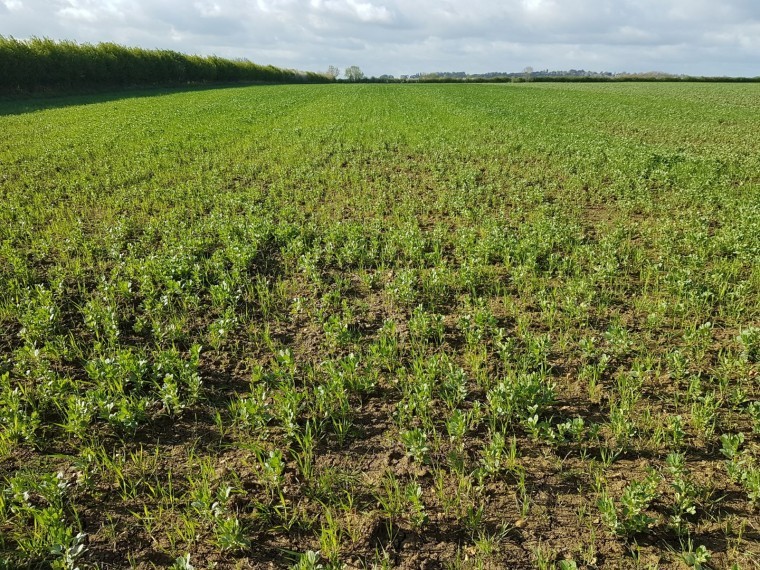The field lab saw three farmers pair crops into teams they hoped would best suit their farms and looked at beans grown with winter wheat; Carlin peas intercropped with triticale; and oil seed rape (OSR) also paired with beans. It was sponsored by the Diversify Horizon 2020 project* and coordinated by the Organic Research Centre in partnership with Innovative Farmers.
Results from the trials have been varied but positive for all three farmers involved in the trials, who have been able to share their knowledge and results with others through the Innovative Farmers network, which enables and promotes farmer-led research.
The farmers reported seeing increased weed suppression, bonus crops, and easier harvesting, and as a result they are continuing the trial next year and encouraging others to take part.
James Hares, from Roundhill Farm in Wiltshire, said: “We are definitely doing this again next year, we’d be stupid not to. In fact, we’ve already ordered our seed.”
Beans and winter wheat team – Roundhill Farm, Wiltshire:
As an organic farmer, James Hares trialled intercropping as a weed prevention technique. He hoped to tackle his wild oat burden by growing winter wheat alongside his bean crop. He drilled the beans at his usual rate (175kg/ha) and added wheat at 50% of his usual drill rate (125kg/ha).
Although his bean yield was slightly lower, the wheat provided an extra crop, and both will be used as feed on farm. In addition, the intercropped plots saw 62% less weed biomass in comparison to the control plots.
He said: “The beans were our main crop so any wheat we got was a bonus – the lower bean yields were more than made up for by the wheat. This is our first foray into intercropping and we are convinced it was worthwhile. Having the extra biomass in the form of a wheat crop – rather than weeds – is hugely beneficial. Next year, we’ll probably drop the wheat rate to around a third to try and boost our bean yield while still suppressing the weeds.”
Carlin pea and triticale team – Green Acres, Shropshire:
Mark Lea, organic pulse grower for Hodmedod’s, grew triticale alongside his Carlin peas with the aim of providing scaffolding for the peas to prevent crops lodging on the ground and make harvesting easier.
He planted triticale at various rates to provide comparison – 0%, 5% (12.5kg/ha), 10% (25kg/ha), 20% (50kg/ha) and 30% (75kg/ha). He found he had the highest pea yield at the 10% rate.
However, he found the peas easier to harvest at the 30% rate and will continue to plant at this higher rate in the next season, particularly as the low rainfall this year meant there was a lower chance of lodging. He also saw a small reduction in weed levels.
Bean and OSR team – Bockhanger Farm, Kent:
Andy Howard from Bockhanger Farm in Kent, who has completed a Nuffield scholarship on intercropping, took part in the field lab as he was looking to grow two marketable crops side-by-side. He conducted a replicated on-farm trial with spring oilseed rape as a companion crop for his beans.
He had a disappointing OSR crop – a wet March meant drilling a month late, plus issues with slugs, wet soils and pollen beetle later in the year. However, he saw an increase in flowering on his beans and is keen to continue the trial next year, hopeful for less challenging weather.
He said: “I was growing the oilseed rape as a companion crop. This year pollen beetle was a major problem in the OSR and we spent money trying to control them, but it didn’t work. Next year, I may use spring OSR again – maybe with a higher value pea – but I won’t spend money on inputs for the companion crop as it’s not worth the risk, whatever we get from OSR will just be a bonus.
“The other interesting thing we noticed was that, in July, the intercropped beans had at least 50% more flowers. They were podding right down the stem whereas the monocrop only started halfway up. Unfortunately, we then had the long, hot spell, meaning that the flower potential didn’t translate to the final yield. Whether this difference was down to seed rates or something else we can’t be sure, but I’m interested to see whether it’s repeated next year.”
As well as the trials on James, Andy and Mark’s farms, there were trial plots at the University of Reading, and the whole field lab was part of Europe-wide research into intercropping and ‘plant teams’ as part of the Diversify, which this year also included on-farm trials in Austria, Denmark, Italy, Portugal, Scotland, Spain and Switzerland alongside plot trials.
Any farmer can take part in next year’s intercropping field lab with Innovative Farmers by contacting group coordinator Charlotte Bickler, from the Organic Research Centre, on charlotte.b@organicresearchcentre.com
Pictured: James Hares – wheat & beans




